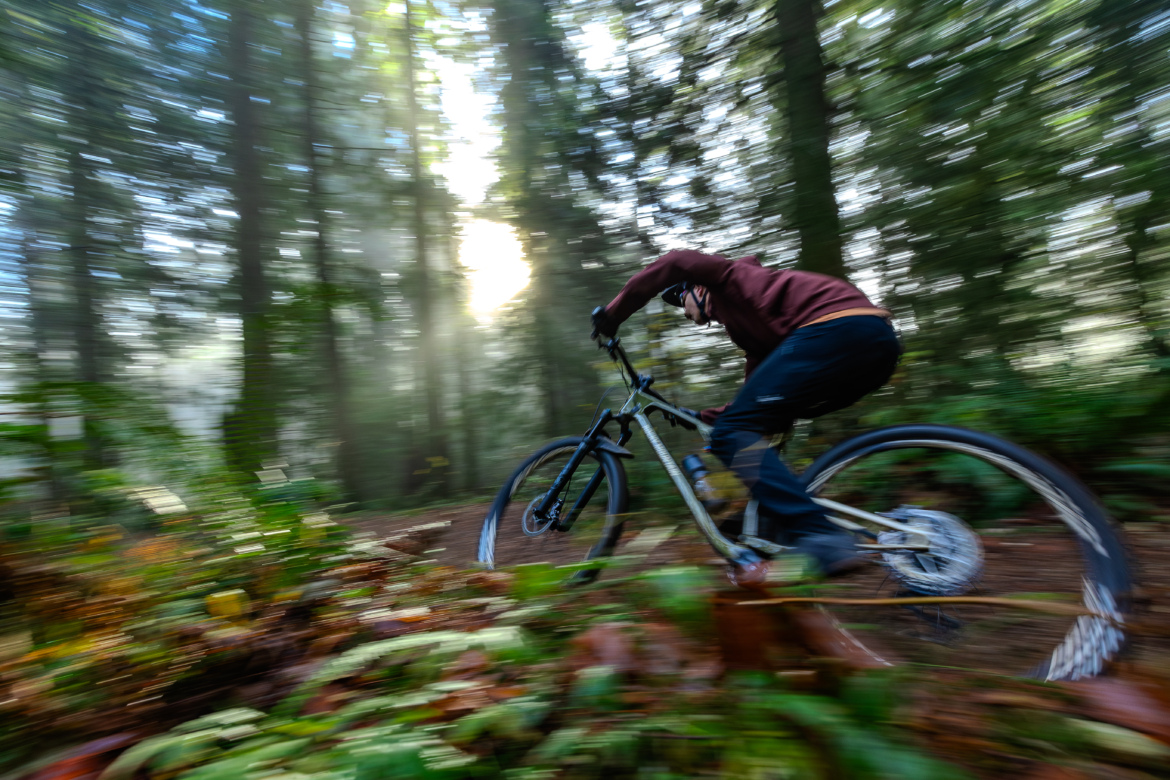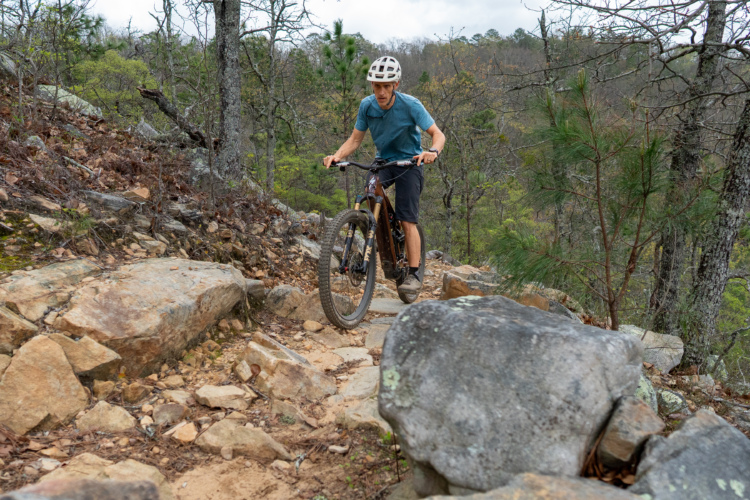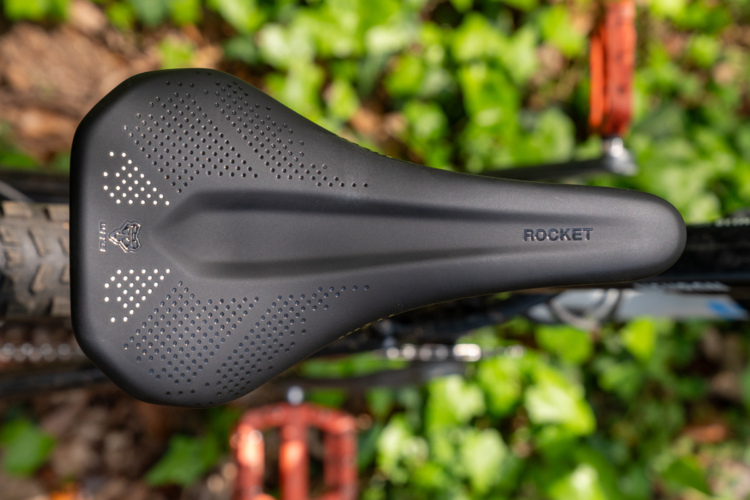
The latest generation Rocky Mountain Element is a cross-country bike that seeks to not only blur the traditional mountain biking genre lines, but to jump right over them. The new Element takes what Rocky Mountain did with the previous version of this category-defying bike, and made some pretty solid changes to keep the Element ahead of the curve. In this review I’ll go over the frame details and build specs and talk about how it performs on the trail, climbing and descending.
2025 Rocky Mountain Element key specs
- Suspension: 120mm rear travel, 130mm front travel
- 65º head tube angle
- 29″ wheels
- 2 x water bottle mounts, 1 x tool mount
- Claimed weight: 26.8lbs
- Sizes XS-XL
- Two build specs + frame only option
- Price: $6,999 for the C70 build tested, $2,999 frame
- Buy from Jenson USA
Frame details
The latest Element cuts a very similar silhouette to the previous one, and that’s no accident. Aside from the fact that a lot of XC bikes seem to be converging on a common layout — see the Element, Santa Cruz Blur, Cervelo ZFS, Orbea Oiz, Merida Ninety Six, and others — the previous generation Element was an excellent bike that was well ahead of its time. Fast-forward a few years, and there still aren’t many bikes out there that check the same geometry, weight, and travel boxes. And believe me, I’ve looked.

So what did Rocky Mountain change on the latest Element frame? Well, there’s one main change that addresses several separate engineering problems: a flex-stay rear end, which Rocky Mountain dubs ‘Smoothlink SL.’ In this arrangement, the chainstay is designed to flex and provide the suspension travel, rather than rotating on a bearing. The flex-stay arrangement means the bike is sort of a single-pivot, but not. The omission of a bearing lowers weight, increases lateral stiffness, improves reliability, and lowers service costs.
Rocky Mountain says they engineered the Smoothlink SL suspension layout to provide all the comfort and traction of their regular Smoothlink bikes with size-specific shock tunes.
The Element was already a light bike, weighing 26lb for my previous test bike; the new frame reportedly drops 350g, though weight for this complete build comes in at a claimed 26.8lbs, no doubt thanks to the lower build spec (C70 vs C90) and burlier components.

The Element’s intentions remain largely the same; it’s a 120/130mm XC/downcountry bike rolling on 29″ rubber, in sizes XS through XL (the XS bike rolls on 27.5″ wheels). It’s meant to be low in weight, and high in fun. Currently coming in only two specs, the C70 and C99, with a frame-only option, the C70 on test here comes in either black, or the Snakebike/Champagne Supernova you see here. The top spec C99 build is offered in a gloss white/silver color, and all three paint options are available on the frameset.

In terms of frame lines and design, the bike casts a very similar shadow, with the front triangle looking near-identical. With its smooth curves and ultra-skinny tubes, the main tell that it’s a new bike is the very skinny chainstay section on the one-piece back end. Featuring fully internal cable routing with the same plastic covers near the head tube, the Element can run wireless or cable-actuated shifting, and cables stay clear of the headset. The rear brake hose can be run either side of the head tube for those who prefer to run their brakes moto (I chose not to, out of laziness).
Similar to the last version, the Element’s front triangle has space for two bottle cages on the spacious down-tube, but adds a tool mount on the underside of the top tube, seen occupied here by a Crank Brothers SOS tool and tube.

Other frame specs include a UDH-compatible dropout, press-in ZS41/52 headset, a pressfit bottom bracket, Boost rear axle, 190x45mm eyelet shock, a 30.9mm seatpost, and a Ride-4 geometry adjustment chip.

Geometry
The geometry on the new Element is literally identical to the last bike, but still progressive for an XC bike. The head tube angle is adjustable between 65-65.8º, the seat angle is 76-76.8º, reaches range from 475-483mm, and the rear center (chainstay length) comes in at 436mm in the size large on test. On paper the new bike should ride pretty similarly to the previous version, which was relatively nimble but stable at speed.

Spec
The Rocky Mountain Element C70 comes with a Fox Performance Elite 34 fork with the new Grip X damper, Float shock, and Transfer seatpost. The drivetrain is SRAM GX Transmission with a 32t chaining up front and 170mm-long cranks on this size large. Braking is taken care of with a pair of SRAM Level Bronze Stealth brakes on 180mm HS2 rotors. The wheels are Race Face ARC27 on a DT Swiss 370 rear hub, and a Novatec front hub wrapped in Maxxis Rekon MaxxTerra EXO 29×2.4 tubeless tires. The cockpit features a Rocky Mountain branded stem with a Race Face Turbine alloy bar and ODI Elite grips.
As far as the spec goes, it’s hard to complain. While I have my reservations about electronic drivetrains still, GX Eagle Transmission is pretty solid, and was relatively fault-free during testing. Race Face ARC rims are not the strongest, but for the type of bike, they should be good, and the new DT Swiss 370 hubs with star ratchet are great, despite low-engagement. I do wish the front hub matched, but I’m nitpicking since it hardly matters.

The latest Fox Grip X damper in the Fox Performance Elite 34 fork is an improvement over the FIT4 damper for sure. The Fox Float shock performed well for me and the Transfer seatpost was good, but not great, suffering the same issues topping out as the Factory Transfer I tested last year.
If I had one main complaint about the build it would be the brakes. It’s not necessarily the lack of power that I dislike, though that certainly is a factor, but the mushy bite-point of SRAM Level 4-piston brakes leaves a lot to be desired. Quite honestly, I wish SRAM would just drop the Level 4 piston; they’re essentially a G2 in a fancy dress, which was itself a slightly refined Guide. The Guide was rubbish since day one, and while they addressed the sticky master cylinder issues a long time ago, this brake is pretty much responsible for all the SRAM brake hate out there. Do yourselves a favor, SRAM, let it go. You’ve proven you can do better with the Maven and the Code.


Photos: Sam James
Currently, there are only two spec levels on offer — C70, and the C99. This is presumably because there are some new specs coming with as-yet unreleased groupsets in the near future. Whether or not we’ll actually see those bikes is another matter. The C70 on test is priced at $6,999 USD, so it’s not cheap, and this is the cheapest complete bike available at the moment, with the exception of the aluminum models.
Climbing
Climbing is what the Element was made to do, and at close to 27lb, it’s no featherweight, but it certainly does go uphill quickly. As with the previous bike, the seated climbing position feels more trail bike than XC bike, which for those coming from a more enduro/trail background will no doubt feel familiar, keeping weight over the front wheel nicely.
I set the Element up at 25% sag for a more efficient ride, and could have gone lower for a plusher ride, but found this to be a good best of both worlds setting between an efficient climber and a fun descender.
As Rocky Mountain’s marketing copy alludes to, the Element delivers traction, and as such has an active ride, meaning it’s not quite as responsive under power as more purely XC-focused bikes. On BC’s chunky climbs, this is no bad thing, where grip is preferable to spinning out. The Maxxis Rekon tires are a rider favorite, and offer a good blend of grip and rolling speed. Having tested the bike through winter here in Vancouver, the only conditions on offer were wet and slippery, and the Rekon works well enough in these conditions, though it requires a fast and light approach; grunt and grind often results in a loss of traction. Thankfully, fast and light is where the Element excels.

The Float Performance Elite rear shock features a two-position open/firm mode adjustment, which I rarely move into firm, since it feels overly firm for on-trail use. It also features a three-position dial for adjusting compression damping in open mode. I found that the firmer mode helped dial out some of the rider-induced suspension movement on the climbs but resulted in a slightly harsh ride on the descents. So, I ultimately settled on the middle position as a compromise between climbing/descending performance.
With regard to geometry, I found myself most comfortable in the steepest position. The spec on the bike lends itself more to climbing than descending, and having changed the way I ride a little recently, I’m happy to enjoy the climbs more. The steepest flip chip position offers snappier handling on the climbs, particularly in tight switchbacks, with fewer chances of pedal strikes. The combination of a firmish rear shock and steep geo mode results in a bike that’s a lot of fun to push hard on the climbs, but leaves enough descending capability for whatever you choose to ride down.
Descending
The Element’s party trick is the way it descends. It’s sharp and lively thanks to a low frame weight and short travel, yet stable thanks to the slackish geometry. Certain components on the bike do hold it back a little, but it’s something I’ve learned to live with. Up-speccing components like brakes and tires would turn the bike into something it wasn’t meant to be. Instead, the Element will happily carry speed on flow trails without fear of being knocked off line. When things get steep and chunky, you’ll want to slow things down.
With short travel and a lively yet stable feel, the Element is at home on lower angle flow trails. Fast and smooth is its jam — trails that aren’t challenging in terms of nasty tech, but feature bonus gaps and jumps are where the bike feels the best. The firm back end lets you pump and pop lips, encouraging you to get air where you can.

Granted, the Element will handle steep and chunky, but you’re going to give the brakes a workout, or get a flat tire. The only mechanical issue during my test was a pinch flat on a tech trail. The suspension is progressive, and I don’t think I ever bottomed the shock out, so burlier tires and brakes would allow the bike to be pushed further, but then maybe you’re on the wrong bike? Lighter tires and brakes mean the Rocky Mountain Element can be enjoyed in both directions. Don’t take this as a criticism though — the Element will go fast if pushed hard, and reward you for it, but it’ll also let you know pretty quickly when you make a mistake. The margin for error is small.
Though the new Fox Grip X damper is a notable improvement over the FIT 4, with high and low speed compression damping adjust that give much more room for tuning, the overall feeling of the fork is less supportive than that of a Grip 2 fork. This is fine, when you realize that the Fox 34 isn’t designed for charging hard on enduro-style descents. When you’re not giving everything on the descents, the more linear feel overall is welcome, with more breathing room than the FIT4.

The elephant in the room
Rocky Mountain’s recent financial woes are no secret. Having recently announced that they’re going into bankruptcy protection and restructuring leaves us wondering where they’ll end up. While this doesn’t affect the way the bike rides, it certainly could affect parts availability and warranty support, though the brand has been working to reassure customers.
Share your 2025 Rocky Mountain Element review
Pros and cons of 2025 Rocky Mountain Element
Pros
- Light frame weight
- Lively, snappy ride
- Great blend of climbing efficiency and descending confidence
Cons
- Under-powered/mushy brakes
- High cost of entry

Bottom line
I said it last time, and I’ll say it again — the Element is the perfect bike for BC Bike Race, or any heavily singletrack-based stage race, and that’s no accident. There are very few bikes out there that blend such a light weight, progressive geometry, and composed handling. The only other one that comes to mind being the Specialized Epic 8 Evo. My Tallboy is close, but it tips the scales several pounds heavier.
The last time around I complained about the fork damper, the brakes, and a low BB. The fork is improved for sure and the brakes are a marginal improvement, but I think in that time I’ve also changed as a rider, and the bikes just makes a bit more sense for me now. The only thing I really wish it had is in-frame storage, but the tool mount makes up for that.
For those looking for a shredder XC bike, or simply a super light trail bike that’s a ton of fun to ride and ridiculously capable for such a lightweight short travel bike, the Element still gets my vote.





















2 Comments
Jan 20, 2025
Jan 21, 2025